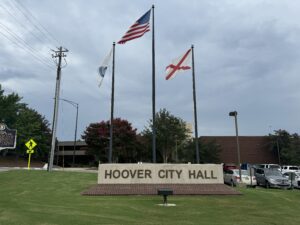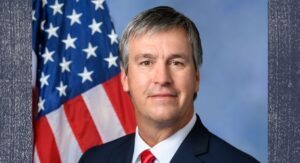Terri Sewell asks FEMA to pay 100% of cost share to counties damaged by January tornadoes
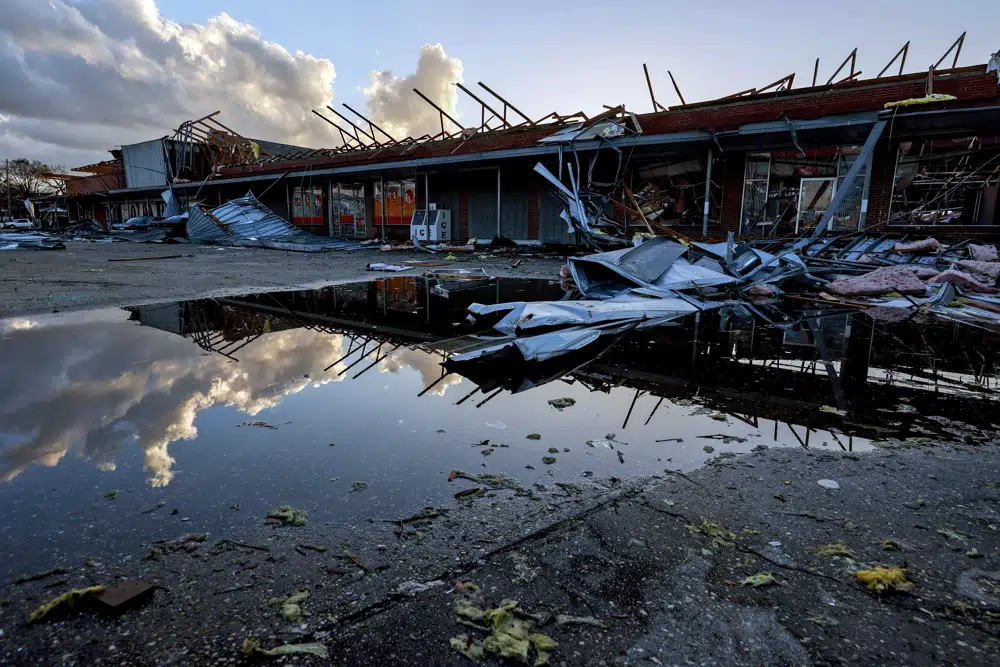
On Thursday, Congresswoman Terri Sewell led members of the Alabama Congressional Delegation in a letter urging President Joe Biden to increase the federal cost share for the FEMA Public Assistance (PA) program for debris removal and emergency protective measures to 100% in response to the severe storms and tornadoes that impacted the State of Alabama on January 12, 2023. President Biden has declared six central Alabama counties a major disaster area. The federal government currently covers at least 75% of eligible costs of FEMA public assistance grants for disaster recovery. “While we are immensely grateful for President Biden’s swift approval of a major disaster declaration, additional federal resources are needed to ensure that our communities can fully recover,” said Rep. Sewell. “So many of our municipalities were still recovering from the financial devastation of Hurricanes Zeta and Sally and the COVID-19 pandemic when the January 12 storms tore through our state. I am proud to lead all nine members of the Alabama Delegation in requesting that President Biden increase the federal cost share for FEMA public assistance from 75 percent to 100 percent, and I thank my colleagues for their strong support.” Sewell spoke on the House Floor describing the damage to Alabama. “In my district alone, 6,000 properties sustained damage, many of to the point of irreparable repair,” Sewell explained. “As officials and volunteers work around the clock to get Alabamians back on their feet following recent devastating storms, there is still a long road to recovery ahead,” said Senator Tommy Tuberville. “I hope President Biden acts swiftly to provide those impacted by the storms with as much support as possible.” “In the aftermath of the severe weather that devastated our communities on January 12, we have seen the very best of our great state – people have banded together to help their fellow Alabamians recover and rebuild,” said Senator Katie Britt. “We are grateful for the incredible first responders, law enforcement officers, and volunteers who continue to devote their time, talent, and resources to these valiant efforts. While we appreciate the swift, collaborative support thus far offered by President Biden and FEMA, the situation on the ground makes it clear that additional federal resources are both warranted and needed as the recovery process moves forward. My office will continue to be in close contact with local, state, and federal officials to see how we can best support affected families, small businesses, and communities.” FEMA’s Public Assistance Program provides supplemental grants to state, tribal, territorial, and local governments, and certain types of private non-profits so communities can quickly respond to and recover from major disasters or emergencies. After an event like a hurricane, tornado, earthquake, or wildfire, communities need help to cover their costs for debris removal, life-saving emergency protective measures, and restoring public infrastructure. The federal share of assistance is at least 75 percent of the eligible cost. To connect with the author of this story, or to comment, email brandonmreporter@gmail.com.
Alabama’s House delegation calls on FEMA to address supply chain shortages affecting Alabama’s electric cooperatives
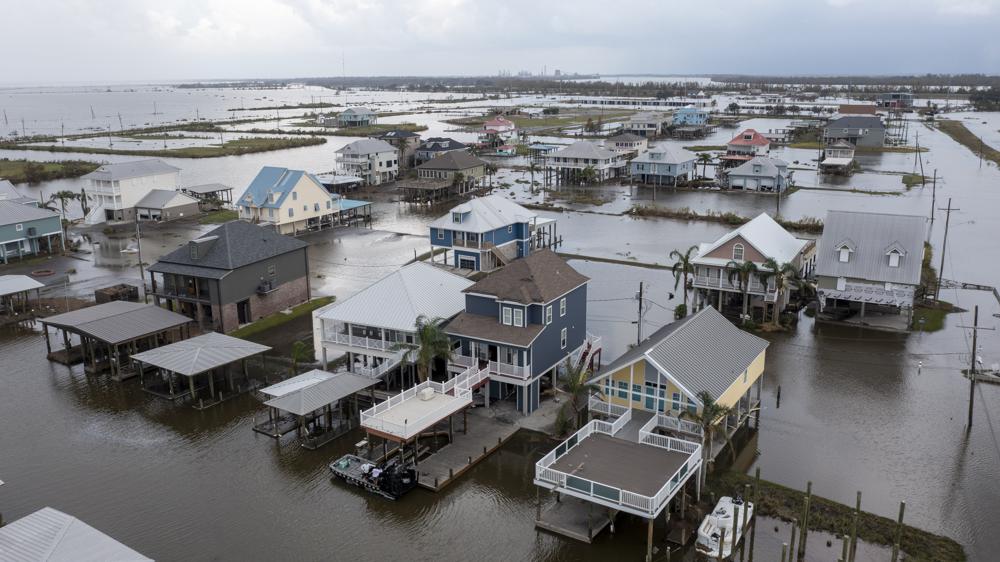
U.S. Rep. Jerry Carl issued the following statement regarding a letter he sent to FEMA Administrator Deanne Criswell regarding supply chain shortages affecting Alabama’s electric cooperatives and municipalities. The letter was cosigned by all seven members of Alabama’s House delegation. “Alabama is no stranger to severe weather. In the aftermath of serious storms, our local electric utility providers play a critical role in repairing and replacing damaged parts of the power grid,” Carl commented. “Unfortunately, supply chain issues have slowed down local utility providers’ ability to prepare for potential threats, leaving Alabama’s power grid more open to damage when disaster occurs.” The letter called on FEMA to provide electric providers with the equipment needed for hurricane season. “With the high chance of an above-average 2022 hurricane season, FEMA must do its part to ensure our local electric providers have access to important equipment before the first hurricane, tropical storm, or natural disaster impacts communities in Alabama. I’m grateful to all my Alabama colleagues for joining me on this letter, and I look forward to hearing back from FEMA Director Criswell with a detailed plan,” Carl concluded.
Federal program offers cash to cover COVID-19 funeral costs

When Wanda Olson’s son-in-law died in March after contracting COVID-19, she and her daughter had to grapple with more than just their sudden grief. They had to come up with the money for cremation. Even without a funeral, the bill came to nearly $2,000, a hefty sum that Olson initially covered. She and her daughter then learned of a federal program that reimburses families up to $9,000 for funeral costs for loved ones who died of COVID-19. Olson’s daughter submitted an application to the Federal Emergency Management Agency, received a deposit by June, and was able to reimburse her mother the $1,974. “Had this not been available, we would have been paying the money ourselves,” said Olson, 80, of Villa Rica, Georgia. “There wasn’t any red tape. This was a very easy, well-handled process.” As of December 6, about 226,000 people had shared in the nearly $1.5 billion that FEMA has spent on funeral costs that occurred after January 20, 2020, the date of the first confirmed case of COVID-19 in the U.S. With the nation’s coronavirus death toll topping 800,000, it’s clear that many families who are eligible for reimbursement have yet to take advantage of the funeral benefit. Her son-in-law was traveling a lot, working on air conditioning systems in theaters, restaurants, and businesses, when he began feeling ill, Olson said. After a few days at home, he went to the hospital and was put on a ventilator. He died several weeks later. “He could never overcome it,” she said. To be eligible for reimbursement, death certificates for those who died after May 16, 2020, must indicate that the death was attributed to COVID-19. For deaths that occurred in the early months of the pandemic — from January 20 to May 16, 2020 — death certificates must be accompanied with a signed statement from a medical examiner, coroner, or the certifying official listed on the certificate indicating that COVID-19 was the cause or a contributing cause of death. The percentage of individuals who have been reimbursed varies dramatically from state to state — from nearly 40% in North Carolina and Maryland to fewer than 15% in Idaho and Oregon, according to state-by-state data compiled by FEMA. While the reimbursement must go directly to individuals, some funeral directors have taken on the task of informing grieving families of the benefit. After the benefit was first announced, David Shipper, owner of the Sunset Funeral Home, Cremation Center & Cemetery in Evansville, Indiana, took out ads to let people know that help was available if they qualified. “Nine thousand dollars — that’s a lot of money. We wanted to find a way to tell people about it,” he said. “We stopped advertising some time ago, but when we have a new family with a death from COVID, we tell them about the program.” Workers at the home will sit down with families, gather the needed paperwork, contact FEMA on the phone and help walk them through the process if they ask, he said. Many families may simply be unaware of the benefit, but others may opt against seeking the cash out of reluctance to revisit the pain of the death, Shipper said. He said the better time to seek help is when planning the funeral. “They’re much more likely to take advantage right then than if they’ve already spent the money and don’t want to open it up again,” Shipper said. The largest states account for some of the biggest shares of the FEMA reimbursement money. The program has paid out more than 21,000 reimbursements in California and Texas, which have both reported more than 74,000 COVID-19 deaths. Residents applied for more than $141 million in each state. The fewest number of reimbursements have occurred in Vermont, where 123 people were awarded a total of about $704,000. Expenses covered under the FEMA program include funeral services, cremation, and interment, as well as the costs for caskets or urns, burial plots or cremation niches, markers or headstones, transportation or transfer of remains, clergy or officiant services, and the use of funeral home equipment or staff. The program has been funded using federal stimulus funds, and money remains available. No online applications are allowed. After all required documents are received and verified, it typically takes fewer than 30 days to determine if an individual is eligible, according to FEMA. Once eligibility is confirmed, applicants who request direct deposit may receive the money in a matter of days. It may take longer for applicants who request a check. The reimbursement is one way of helping ease the emotional and financial burden that the pandemic has wreaked on communities across the country, according to Ellen Wynn McBrayer, president of Jones-Wynn Funeral Homes & Crematory in Villa Rica, Georgia. She recalled one woman who lost her mother, husband, and one of her children to the disease in the span of six months. One of the workers at the funeral home also succumbed to the virus. “To have to help a grieving family is hard on a normal day, but to see so many deaths,” she said. “COVID has just broken a lot of hearts and taken a lot of lives.” Republished with the permission of the Associated Press.
Joe Biden says Ida, wildfires show ‘climate crisis’ has struck

President Joe Biden on Thursday pledged robust federal help for the Northeastern and Gulf states battered by Hurricane Ida and for Western states beset by wildfires — with the catastrophes serving as deadly reminders that the “climate crisis” has arrived. “These extreme storms, and the climate crisis, are here,” Biden said in a White House speech. “We must be better prepared. We need to act.” The president said he will further press Congress to pass his nearly $1 trillion infrastructure bill to improve roads, bridges, the electric grid, and sewer systems. The proposal intends to ensure that the vital networks connecting cities and states and the country as a whole can withstand the flooding, whirlwinds, and damage caused by increasingly dangerous weather. Biden stressed that the challenge transcends the politics of a deeply divided nation because of the threats posed by the storms and fires. “It’s a matter of life and death, and we’re all in this together,” the president said. Scientists say climate change increases the frequency of extreme weather events — such as large tropical storms and the droughts and heatwaves that create conditions for vast wildfires. U.S. weather officials recently reported that July 2021 was the hottest month ever recorded in 142 years of record-keeping. Ida was the fifth-most powerful storm to strike the U.S. when it hit Louisiana on Sunday with maximum winds of 150 mph (240 kph), likely causing tens of billions of dollars in flood, wind, and other damage, including to the electrical grid. The storm’s remnants dropped devastating rainfall across parts of Maryland, Pennsylvania, New York, and New Jersey on Wednesday, causing significant disruption to major population centers. The storm has killed at least 13 in the Gulf Coast region and at least 46 in the Northeastern U.S. More than 1 million homes and businesses in Louisiana and Mississippi remained without power after Ida toppled a major transmission tower and knocked out thousands of miles of lines and hundreds of substations. New Orleans was plunged into total darkness; power began returning to parts of the city Wednesday. Biden is set to visit Louisiana on Friday to survey some of the damage and meet with government officials there. Biden said the flooding in Louisiana was less than the region experienced 16 years ago during Hurricane Katrina, crediting federal investments in the area’s levee system. “We know that there is much to be done in this response on our part,” Biden added. “We need to get power restored. We need to get more food, fuel, and water deployed.” He said he was receiving hourly updates on the disaster response and outlined efforts by the federal government to ease recovery efforts, including by making satellite imagery available to utility companies and waiving some regulatory requirements. At Biden’s request, the Energy Department said it was releasing 1.5 million barrels of oil from the nation’s Strategic Petroleum Reserve to ensure a steady fuel supply in the Gulf region, where sunken vessels are blocking key supply lines along the Mississippi River. The oil will be used by ExxonMobil at its Baton Rouge refinery. The company has agreed to replenish the strategic reserve, which is used as an emergency stockpile, within three months. The president also scolded insurers who are declining to pay for the costs of damage or hotel stays for people who had to evacuate their homes. “Don’t hide behind the fine print and technicalities,” Biden warned the insurers. “Do the right thing and pay your policyholders what you owe them.” Biden said separately that the Pentagon was assisting with ongoing firefighting operations in California against the Caldor fire. Louisiana Gov. John Bel Edwards suggested Biden’s Friday visit would be crucial for the president to understand the destruction by seeing the widespread damage for himself. “There’s nothing quite like visiting in person,” Edwards told reporters Wednesday following a briefing with local elected officials in Jefferson Parish, which took direct blows from Ida. “When you see it for yourself, it is just so much more compelling.” Asked what type of assistance he planned to request from Biden, Edwards said, “Quite frankly, the list is going to be very, very long.” But he said a priority would be for a housing program to help people rebuild. The White House says Biden has held several conference calls with governors and local officials to discuss preparations and needs after the storm and has received briefings from Federal Emergency Management Agency Administrator Deanne Criswell. FEMA had sent tons of supplies, including generators, tarps, and other materials to the region before the storm, and federal response teams are working on search and rescue. Biden’s trip Friday to the Gulf region will cap a difficult stretch for the president, who oversaw the chaotic exit of the U.S. military from Afghanistan after a 20-year engagement. That included the deaths of 13 U.S. service members helping evacuate more than 120,000 Americans, Afghan allies, and others fleeing life under Taliban rule. As Ida bore down on the Gulf Coast on Sunday, Biden was at Dover Air Force Base in Delaware to witness the return of the remains of the 13 U.S. servicemen and women who were killed in a suicide bombing last week at Afghanistan’s airport in Kabul, where the evacuations were taking place. Republished with the permission of the Associated Press.
Hurricane Ida traps Louisianans, shatters the power grid
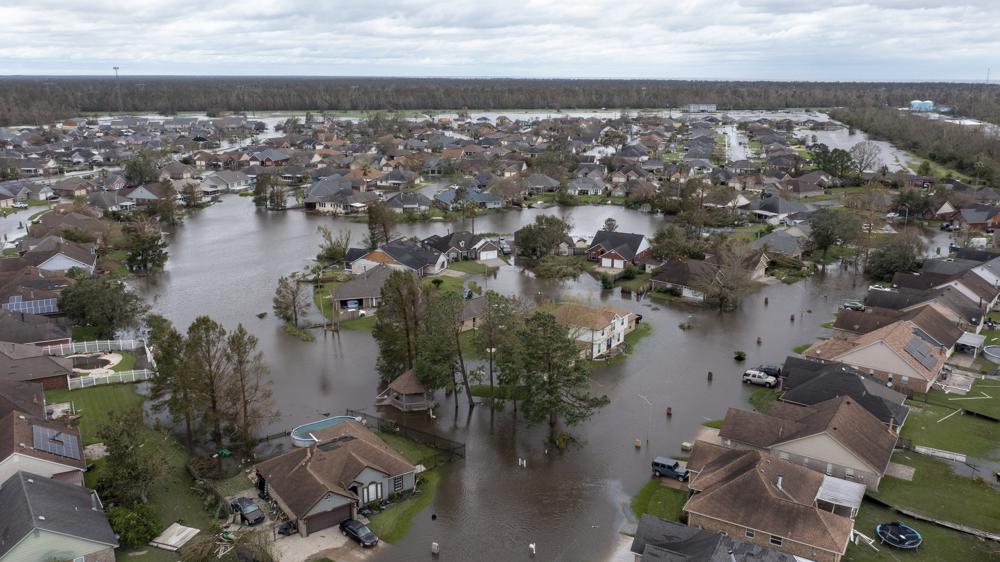
Rescuers in boats, helicopters, and high-water trucks brought people trapped by Hurricane Ida’s floodwaters to safety Monday, and utility repair crews rushed in after the furious storm swamped the Louisiana coast and ravaged the electrical grid in the stifling, late-summer heat. Residents living amid the maze of rivers and bayous along the state’s Gulf Coast retreated desperately to their attics or roofs and posted their addresses on social media with instructions for search-and-rescue teams on where to find them. More than 1 million homes and businesses in Louisiana and Mississippi — including all of New Orleans — were left without power as Ida, one of the most powerful hurricanes ever to hit the U.S. mainland, pushed through on Sunday. The damage was so extensive that officials warned it could be weeks before the power grid was repaired. As the storm was downgraded to a tropical depression Monday afternoon and continued to make its way inland with torrential rain, it was blamed for at least two deaths — a motorist who drowned in New Orleans and a person hit by a falling tree outside Baton Rouge. But with many roads impassable and cellphone service out in places, the full extent of its fury was still coming into focus. Christina Stephens, a spokesperson for Gov. John Bel Edwards, said that given the level of destruction, “We’re going to have many more confirmed fatalities.” The governor’s office said damage to the power grid appeared “catastrophic” — dispiriting news for those without refrigeration or air conditioning during the dog days of summer, with highs forecast in the mid-80s to near 90 by midweek. “There are certainly more questions than answers. I can’t tell you when the power is going to be restored. I can’t tell you when all the debris is going to be cleaned up and repairs made,” Edwards told a news conference. “But what I can tell you is we are going to work hard every day to deliver as much assistance as we can.” Debbie Greco, her husband, and her son rode out the storm in LaPlace with Greco’s parents. Water reached the first-floor windows, then knocked down the back door and filled the brick home with 4 feet of water. They retreated to the second floor, but then screaming winds collapsed the roof. They were finally rescued by boat after waiting in the only dry spot, five people sharing the landing on the stairs. “When I rebuild this, I’m out of here. I’m done with Louisiana,” said Greco’s father, 85-year-old Fred Carmouche, a lifelong resident. Elsewhere in LaPlace, people pulled pieces of chimneys, gutters, and other parts of their homes to the curb, and residents of a mobile home park waded through floodwaters. In just three parishes, 191 people and 27 pets had been rescued by Monday afternoon, Edwards said. The hurricane blew ashore on the 16th anniversary of Katrina, the 2005 storm that breached New Orleans’ levees, devastated the city, and was blamed for 1,800 deaths. This time, New Orleans appeared to escape the catastrophic flooding city officials had feared. Stephanie Blaise returned to her home with her father in New Orleans’ Lower Ninth Ward after evacuating. The neighborhood suffered devastating flooding in Katrina but only lost some shingles in Ida. However, with no idea when electricity would be restored, Blaise didn’t plan to stay long. “We don’t need to go through that. I’m going to have to convince him to leave. We got to go somewhere. Can’t stay in this heat,” she said. The city urged people who evacuated to stay away for at least a couple of days because of the lack of power and fuel. “There’s not a lot of reasons to come back,” said Collin Arnold, chief of emergency preparedness. Also, 18 water systems serving about 255,000 customers in Louisiana were knocked out of service, the state Health Department said. Four Louisiana hospitals were damaged, and 39 medical facilities were operating on generator power, the Federal Emergency Management Agency said. Officials said they were evacuating scores of patients to other cities. The governor’s office said over 2,200 evacuees were staying in 41 shelters, a number expected to rise as people were rescued or escaped flooded homes. The governor’s spokesperson said the state will work to move people to hotels as soon as possible so they can keep their distance from one another. “This is a COVID nightmare,” Stephens said, adding: “We do anticipate that we could see some COVID spikes related to this.” Preliminary measurements showed Slidell, Louisiana, got at least 15.7 inches of rain, while New Orleans received nearly 14 inches, forecasters said. Other parts of Louisiana and Mississippi, Alabama and Florida got 5 to 11 inches. The Louisiana National Guard said it activated 4,900 Guard personnel and lined up 195 high-water vehicles, 73 rescue boats, and 34 helicopters. Local and state agencies were adding hundreds more. Edwards said he decided not to tour hurricane damage by air Monday to add one more aircraft to the effort. On Grand Isle, the 40 people who stayed on the barrier island through the brunt of the hurricane gave aircraft checking on them Monday a thumbs-up, Jefferson Parish Sheriff Joe Lopinto said. The road to the island remained impassable, and rescuers would try to reach them as soon as they are able, the sheriff said. The hurricane twisted and collapsed a giant tower that carries key transmission lines over the Mississippi River to the New Orleans area, causing widespread outages, Entergy and local authorities said. The power company said more than 2,000 miles of transmission lines were out of service, along with 216 substations. The tower had survived Katrina. The storm also flattened utility poles, toppled trees onto power lines, and caused transformers to explode. The governor said 25,000 utility workers were in the state to help restore electricity, with more on the way. “We’re going to push Entergy to restore power just as soon as they can,” Edwards said. AT&T said its wireless network in Louisiana was reduced to
Donald Trump to visit tornado victims in eastern Alabama Friday

President Donald Trump is scheduled to visit eastern Alabama on Friday to survey the areas in Lee County devastated by deadly tornadoes that left 23 people dead on Sunday. “Heading now to the Great State of Alabama!” Trump tweeted Friday morning. Heading now to the Great State of Alabama!— Donald J. Trump (@realDonaldTrump) March 8, 2019 Alabama officials say in his visit, Trump will see firsthand the “catastrophic” damage where a massive EF4 tornado left a path of destruction nearly a mile wide with 170 mph (270 kph) winds. According to the Associated Press, “As he left Washington, President Donald Trump said he expected to meet with Gov. Kay Ivey and people who ‘got hit very hard by the tornadoes.’ He also planned to thank first responders.” Trump’s visit follows a tweet earlier this week promising “A Plus treatment” by the Federal Emergency Management Agency (FEMA). “FEMA has been told directly by me to give the A Plus treatment to the Great State of Alabama and the wonderful people who have been so devastated by the Tornadoes. @GovernorKayIvey, one of the best in our Country, has been so informed. She is working closely with FEMA (and me!).,” Trump tweeted Monday. FEMA has been told directly by me to give the A Plus treatment to the Great State of Alabama and the wonderful people who have been so devastated by the Tornadoes. @GovernorKayIvey, one of the best in our Country, has been so informed. She is working closely with FEMA (and me!).— Donald J. Trump (@realDonaldTrump) March 4, 2019
Donald Trump taps Jeffrey Byard, another former Alabama official, to lead FEMA
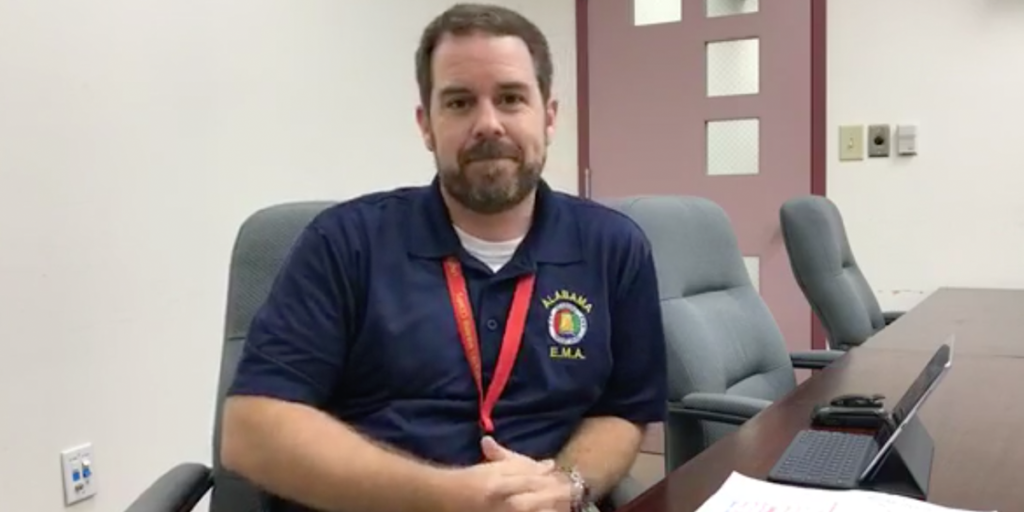
Following the resignation of Federal Emergency Management Agency (FEMA) Director Brock Long, who previously served as Director of the Alabama Emergency Management Agency (AEMA), President Donald Trump announced he will nominate another former Alabama official to head the federal agency. Trump will nominate Jeffrey Byard, who first joined FEMA in Sept. 2017 during the agency’s response efforts to Hurricanes Harvey in Texas and Irma in Florida, when he was appointed as the Associate Administrator for the Office of Response and Recovery (ORR). Byard had previously served as Executive Operations Officer at AEMA. During his tenure with there, Byard was responsible for the creation and implementation of the Alabama field response structure, which resulted in a more effective and efficient response and recovery model. He also served as the Deputy State Coordinating Officer for the nation’s first large scale host state evacuation event during Hurricane Gustav. From 2006-2007, he served as the Director of Alabama’s Transitional Recovery Office where he led and coordinated the timely delivery of FEMA’s disaster recovery and assistance support to state and local governments.
FEMA Chief, former Alabama leader, Brock Long resigns
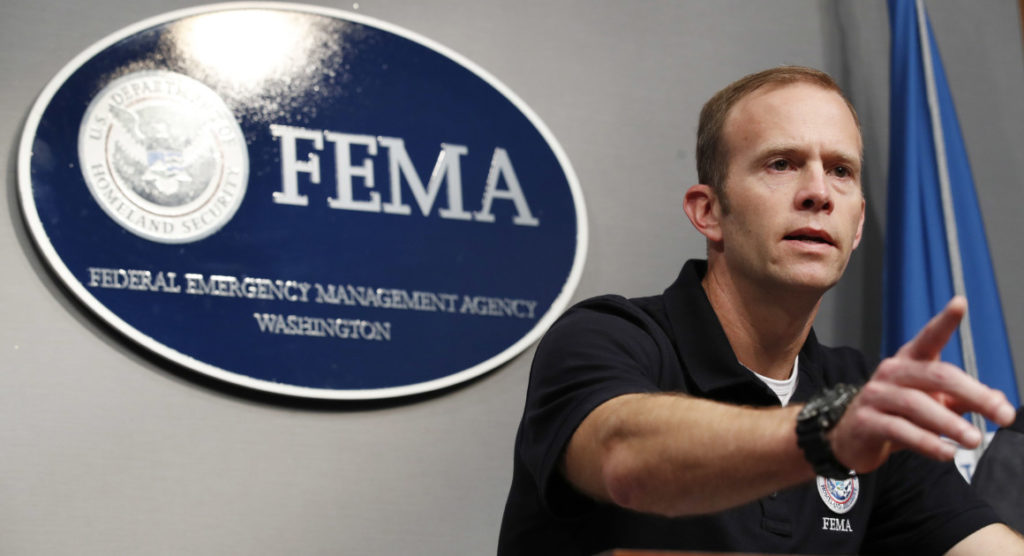
Former Director of the Alabama Emergency Management Agency (AEMA) and current Federal Emergency Management Agency (FEMA) Director Brock Long announced his resignation on Wednesday. “It has been a great honor to serve our country as @fema Administrator for the past two years. While this has been the opportunity of the lifetime, it is time for me to go home to my family,” Long tweeted. It has been a great honor to serve our country as @fema Administrator for the past two years. While this has been the opportunity of the lifetime, it is time for me to go home to my family. You can read my full announcement here: https://t.co/2HXa7tQtV8 — Brock Long (@FEMA_Brock) February 13, 2019 Long’s resignation comes month after an internal investigation by the DHS inspector general (IG) found that he used government vehicles without proper authorization. He did not lose his job over it. Long served at the helm of the AEMA from 2008 to 2011, where he worked on the Yellowhammer State’s response to the Deepwater Horizon oil spill and numerous other natural disasters. As Director, he served as the State Coordinating Officer for 14 disasters, including eight presidentially-declared events. Prior to that he was a FEMA Regional Hurricane Program Manager from 2001 to 2006. Deputy Administrator Pete Gaynor will now serve as acting head of the agency. This story is breaking.
Amid budget overages, Montgomery Fire/Rescue receives much-needed $3.5M grant
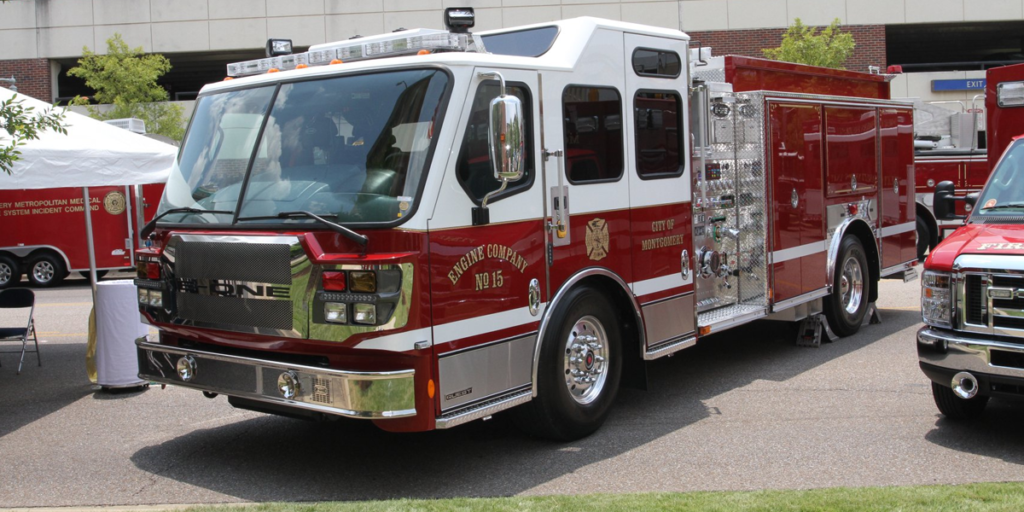
Just when things were starting to looking fiscally grim, as news broke that the Montgomery Fire/Rescue (MFR) Department had shockingly exceeded its overtime budget by over $2M thus far in 2018, the city was awarded a much-needed federal grant that will help keep operations running smoothly. U.S. Senator Richard Shelby on Tuesday announced the $3,553,843 award as a part of the Federal Emergency Management Agency’s (FEMA) Staffing for Adequate Fire & Emergency Response (SAFER) grant program. “The funding will ensure the city has the proper resources and staff to adequately respond to emergency medical, fire, and rescue incidents throughout the area. I am proud that FEMA has awarded this SAFER grant to facilitate increased safety and security in the City of Montgomery,” said Shelby. As of mid-August, MFR had spent $2.2 million on overtime. That amounts to $2,079,470 more than expected, or 1,411 percent over budget. The $3.5 million grant will be used to help hire additional firefighters and first responders over a three year period to achieve and maintain proper staffing levels. “We could not be more grateful to Sen. Richard Shelby for his role in helping Montgomery secure this SAFER grant to increase the number of firefighters who serve and protect our capital city,” said Montgomery Mayor Todd Strange. “The additional 33 firefighters provided by this grant will help us meet the increasing demand for suppression and emergency medical services. Sen. Shelby’s support for this grant award speaks to his abiding commitment to the public’s safety and his unflagging work on behalf of our city and state.” SAFER grants are awarded to fire departments and national, state, local, tribal, or territorial organizations that represent the interests of firefighters.
Donald Trump issues disaster declaration for Ala. counties following delegation letter
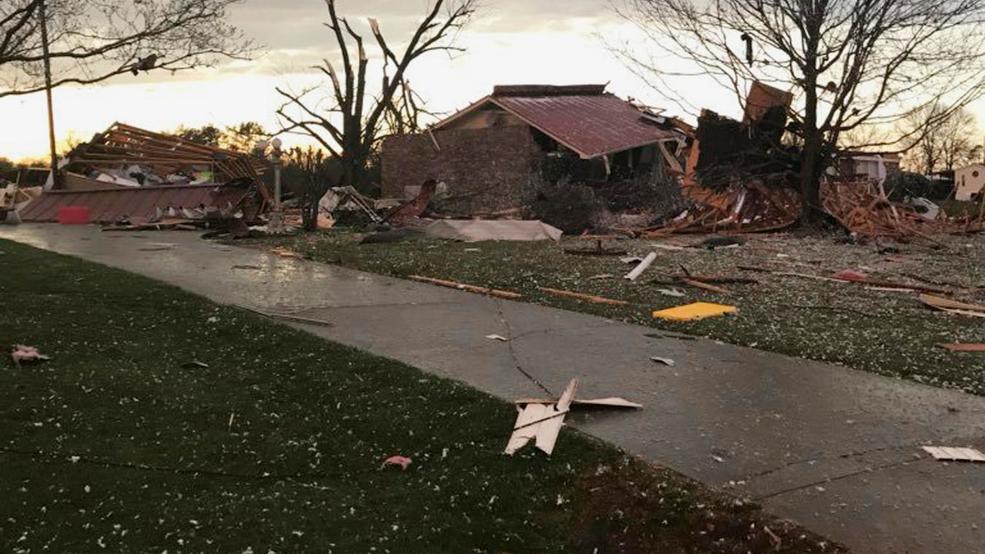
Following a letter from the Alabama delegation, President Donald Trump directed the Federal Emergency Management Agency (FEMA) to make federal disaster aid available to the State of Alabama to supplement state and local recovery efforts in the area affected by severe storms and tornadoes during the period of March 19, 2018 through March 20, 2018. The congressional delegation letter — led by Sen. Richard Shelby, signed by entire delegation including U.S. Sen Doug Jones, along with U.S. Reps. Bradley Byrne (AL-01), Martha Roby (AL-02), Mike Rogers, (R-Ala.), Robert Aderholt (AL-04), Mo Brooks (AL-05), Gary Palmer (AL-06), and Terri Sewell (AL-07) — encouraged the President to issue the disaster declaration that would trigger the release of federal funds to help people and communities recover from the severe storms and tornadoes that occurred March 19-20, 2018. During the night of the 19th into the morning of the 20th, severe storms spawned tornadoes, damaged homes and downed trees as they moved across the Southeast. “This disaster declaration is critical following the significant destruction that occurred throughout the state, but specifically in these four Alabama counties,” said Shelby. “I am grateful that the President has decided to send federal recovery resources to assist in the rebuilding of our communities.” Gov. Kay Ivey also requested Trump grant disaster assistance. “The recovery process following a disaster is a long and tough road and I appreciate President Trump for approving this major disaster declaration request,” Ivey said. “This declaration will provide much needed assistance to Alabamians affected by the March 19th storms and will ease the burden on local governments as they continue the recovery process.” The President’s action makes federal funding available to affected individual homeowners and renters in Calhoun, Cullman and Etowah counties. Residents within the counties may now apply for federal disaster assistance for uninsured and underinsured damage and losses resulting from the March 19th storms. Assistance for eligible survivors can include grants for temporary housing and home repairs, and for other serious disaster-related needs, such as medical and dental expenses. Long-term, low-interest disaster loans from the U.S. Small Business Administration (SBA) may also be available to cover losses not fully compensated by insurance and that do not duplicate benefits of other agencies or organizations. “I cannot thank our federal partners enough for their support during the joint damage assessments as well as the constant communication as we awaited final approval,” Director Brian E. Hastings said. “Recovering from disasters requires the whole community. Volunteers, first responders and local Emergency Management officials have done an exceptional job during the response phase and now we are pleased to have federal assistance to help with the long recovery process.” For information on how to register with FEMA, you can do so by phone or online: Online at DisasterAssistance.gov, or On the FEMA Mobile App, or by Calling 800-621-3362 (FEMA). Applicants who use Video Relay Service may also call 800-621-3362. People who are deaf, hard of hearing or have a speech disability and use a TTY may call 800-462-7585 directly; for those who used 711 or Video Relay Service (VRS), call 1-800-621-3362. The toll-free numbers are open from 7 a.m. to 11 p.m. ET, seven days a week. Federal funding is also available on a cost-sharing basis for hazard mitigation measures. The purpose of the program is to reduce the loss of life and property due to natural disasters and to enable mitigation measures to be implemented during the immediate recovery from a disaster. Read the letter from the Alabama delegation: Mr. President: As members of the Alabama delegation, we write in strong support of Governor Kay Ivey’s request for a federal disaster declaration for Cullman, St. Clair, Calhoun, and Etowah counties. On March 19, 2018, severe storms and tornadoes touched down in the eastern part of Alabama and caused catastrophic damage in 27 counties across the state. In less than 24 hours, Governor Ivey declared a State of Emergency. Local emergency management agencies aided the impacted residents and, with assistance from regional FEMA officials, prepared their Preliminary Damage Assessment. State officials have estimated substantial damages across these counties. Considering the scope and intensity of this natural disaster, we ask that you carefully review Governor Ivey’s request and approve a federal disaster declaration. In doing so, you will allow thousands of Americans to begin the slow process of rebuilding their lives after this terrible incident.
Donald Trump says Puerto Rico can’t get hurricane aid ‘forever’
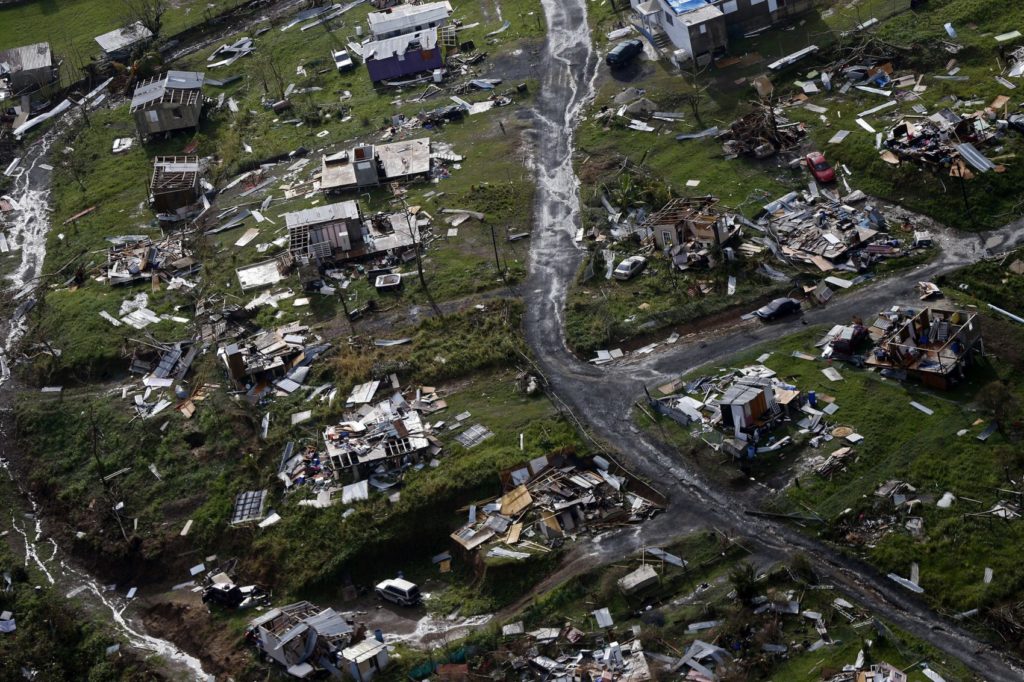
President Donald Trump lashed out at hurricane-devastated Puerto Rico on Thursday, insisting that federal help will be limited and blaming the U.S. territory for its financial struggles. The broadside came as the House headed toward passage of a $36.5 billion disaster aid package, including assistance for Puerto Rico. Puerto Rico has been reeling since Hurricane Maria struck three weeks ago, leaving death and destruction in an unparalleled humanitarian crisis. Forty-five deaths in Puerto Rico have been blamed on Maria, 90 percent of the island is still without power and the government says it hopes to have electricity restored completely by March. Trump tweeted: “We cannot keep FEMA, the Military & the First Responders, who have been amazing (under the most difficult circumstances) in P.R. forever!” In a series of tweets, the president said “electric and all infrastructure was disaster before hurricanes.” He blamed Puerto Rico for its looming financial crisis and “a total lack of accountability.” Democrats said Trump’s attacks were “shameful,” given that the 3 million-plus U.S. citizens on Puerto Rico are confronting the kind of hardships that would draw howls of outrage if they affected a state. One-third of the island lacks clean running water and just 8 percent of its roads are passable, according to government statistics. “It is shameful that President Trump is threatening to abandon these Americans when they most need the federal government’s help,” said Maryland Rep. Steny Hoyer, the second-ranking House Democrat. The legislative aid package totals $36.5 billion and sticks close to a White House request. For now, it ignores huge demands from the powerful Florida and Texas delegations, which together pressed for some $40 billion more. A steady series of disasters could put 2017 on track to rival Hurricane Katrina and other 2005 storms as the most costly set of disasters ever. Katrina required about $110 billion in emergency appropriations. The bill combines $18.7 billion for the Federal Emergency Management Agency with $16 billion to permit the financially troubled federal flood insurance program pay an influx of Harvey-related claims. An additional $577 million would pay for western firefighting efforts. Up to $5 billion of the FEMA money could be used to help local governments remain functional as they endure unsustainable cash shortfalls in the aftermath of Maria, which has choked off revenues and strained resources. House Speaker Paul Ryan, R-Wis., planned to visit Puerto Rico on Friday. He has promised that the island will get what it needs. “It’s not easy when you’re used to live in an American way of life, and then somebody tell you that you’re going to be without power for six or eight months,” said Resident Commissioner Jenniffer Gonzalez-Colon, who represents Puerto Rico as a nonvoting member of Congress. “It’s not easy when you are continue to suffer – see the suffering of the people without food, without water, and actually living in a humanitarian crisis.” The GOP-run Congress had protracted debates last year on modest requests by former President Barack Obama to combat the Zika virus and help Flint, Michigan, repair its lead-tainted water system. Now, it is moving quickly to take care of this year’s crises, quickly passing a $15.3 billion measure last month and signaling that another installment is coming next month. Several lawmakers from hurricane-hit states said a third interim aid request is anticipated shortly – with a final, huge hurricane recovery and rebuilding package likely to be acted upon by the end of the year. Republished with permission from the Associated Press.
Another Alabama emergency management officer, Jeff Byard, joins FEMA leadership

Alabama is losing another emergency management leader to the Federal Emergency Management Agency (FEMA). Alabama Emergency Management Agency (AEMA)’s Executive Operations Officer Jeff Byard has been appointed the Associate Administrator for the Office of Response and Recovery (ORR) at FEMA. Byard joins fellow AEMA alum, FEMA Director Brock Long who joined the agency last month, in his new post where he will focus on the agency’s ability, and those of its partners and stakeholders, to respond to all catastrophic events through building, sustaining, and improving response and recovery capabilities. During his tenure with the AEMA, Byard was responsible for the creation and implementation of the Alabama field response structure, which resulted in a more effective and efficient response and recovery model. He also served as the Deputy State Coordinating Officer for the nation’s first large scale host state evacuation event during Hurricane Gustav. From 2006-2007, he served as the Director of Alabama’s Transitional Recovery Office where he led and coordinated the timely delivery of FEMA’s disaster recovery and assistance support to state and local governments. Byard holds a Bachelor of Science degree from Troy University, and is a graduate of the Alabama Public Safety Leadership Academy at Alabama. He was sworn in to his new position Monday morning in the National Response Coordination Center.

